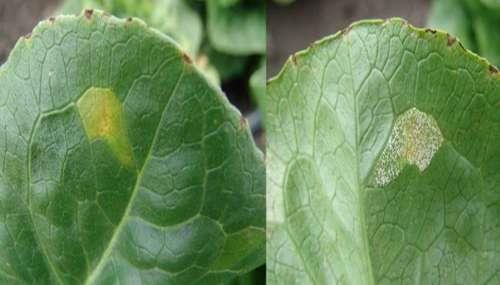By Leah Fronk
However, when growing lettuce in a protected setting during the colder months, downy mildew can affect the yield and quality of lettuce.
Lettuce downy mildew (DM), Bremia lactucae, is favored in cool, moist environments, often found in low tunnels or greenhouses in late fall and winter. Lettuce downy mildew is caused by a fungal-type organism, an oomycete, that enjoys damp, wet conditions. Growers may notice white fuzzy sporulation on the underside of the leaves, which could be easily mistaken for powdery mildew. Primary symptoms of lettuce downy mildew include leaf yellowing in angular patches. Yellow patches observed on the upper leaf surface may correlate with white sporulation on the lower leaf surface, as shown in the photo. The yellow patches turn brown and papery as the disease progresses, and the leaf tissue dies. Discoloration of red leaf lettuce may appear more gray than yellow. Older, mature leaves are usually the first to show symptoms of DM. Damaged leaf tissue may allow for the entry of secondary pathogens, reducing yield and making lettuce quality worse.

Composite photo showing both sides of the same leaf.
Cucurbit downy mildew is caused by a different causal agent than lettuce downy mildew. Spinach is affected by yet another downy mildew organism. When growers observe lettuce downy mildew in protected cultures, they should not blame the occurrence of cucurbit downy mildew debris in fields. Downy mildew can be persistent in overwintering spores or blown in from other regions. The role of seed contamination associated with downy mildew is not certain.
As with many plant diseases, prevention is the best strategy. Use the heater and vents in the greenhouse to remove moist air. Employ irrigation practices that reduce leaf wetness. Fungicides are available that are oomycete-specific. A few conventional products available for greenhouse use include Tanos, Ranman*, Curzate, Aliette, Fontelis, and Sonata. Some fungicide products can be tank-mixed with copper to increase protection (*Do not tank-mix Ranman with copper-based fungicides, or plant injury may be observed).
Rotate modes of action so that the pathogen does not become resistant to the fungicides you are using. Organic options include Stargus, Cease, Actinovate, and copper. As with the application of any product, conventional or organic, please read the label to ensure you are using it properly.
Lettuce downy mildew tends to develop new races, so proper pathogen diagnosis is essential. Careful selection of resistant or tolerant plant varieties may help to ease disease pressure. The Penn State Plant Disease Clinic is open year-round to accept plant samples for diagnosis. Visit their website for instructions or contact your Extension Educator for assistance.
Source : psu.edu